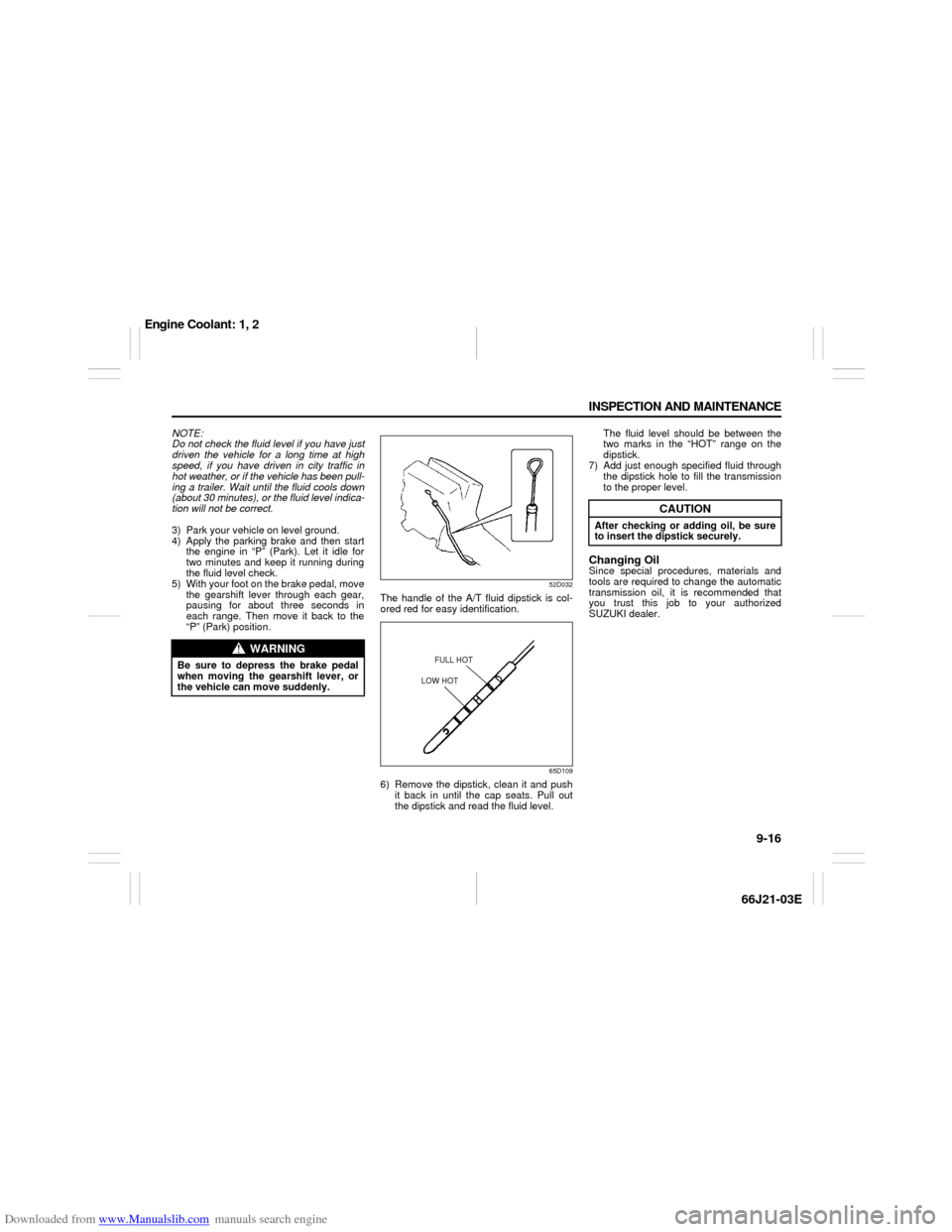2007 SUZUKI GRAND VITARA seats
[x] Cancel search: seatsPage 154 of 211

Downloaded from www.Manualslib.com manuals search engine 9-16 INSPECTION AND MAINTENANCE
66J21-03E
NOTE:
Do not check the fluid level if you have just
driven the vehicle for a long time at high
speed, if you have driven in city traffic in
hot weather, or if the vehicle has been pull-
ing a trailer. Wait until the fluid cools down
(about 30 minutes), or the fluid level indica-
tion will not be correct.
3) Park your vehicle on level ground.
4) Apply the parking brake and then start
the engine in “P” (Park). Let it idle for
two minutes and keep it running during
the fluid level check.
5) With your foot on the brake pedal, move
the gearshift lever through each gear,
pausing for about three seconds in
each range. Then move it back to the
“P” (Park) position.
52D032
The handle of the A/T fluid dipstick is col-
ored red for easy identification.
65D109
6) Remove the dipstick, clean it and push
it back in until the cap seats. Pull out
the dipstick and read the fluid level. The fluid level should be between the
two marks in the “HOT” range on the
dipstick.
7) Add just enough specified fluid through
the dipstick hole to fill the transmission
to the proper level.
Changing OilSince special procedures, materials and
tools are required to change the automatic
transmission oil, it is recommended that
you trust this job to your authorized
SUZUKI dealer.
WARNING
Be sure to depress the brake pedal
when moving the gearshift lever, or
the vehicle can move suddenly.
FULL HOT
LOW HOT
CAUTION
After checking or adding oil, be sure
to insert the dipstick securely.
Engine Coolant: 1, 2
Page 170 of 211

Downloaded from www.Manualslib.com manuals search engine 9-32 INSPECTION AND MAINTENANCE
66J21-03E
GLOSSARY OF TIRE TERMINOL-
OGYAccessory Weight – the combined weight
(in excess of those standard items which
may be replaced) of automatic transmis-
sion, power steering, power brakes, power
windows, power seats, radio, and heater,
to the extent that these items are available
as factory-installed equipment (whether
installed or not).
Cold Tire Inflation Pressure – the pressure
in a tire that has been driven less than 1
mile or has been standing for three hours
or more.
Curb Weight – the weight of a motor vehi-
cle with standard equipment including the
maximum capacity of fuel, oil, and coolant,
and, if so equipped, air conditioning and
additional weight optional engine.
Intended Outboard Sidewall – (1) the side-
wall that contains a whitewall, bears white
lettering or bears manufacturer, brand,
and/or model name molding that is higher
or deeper than the same molding on the
other sidewall of the tire, or (2) the outward
facing sidewall of an asymmetrical tire that
has a particular side that must always face
outward when mounted on a vehicle.
Maximum Inflation Pressure – the maxi-
mum cold inflation pressure a tire is
designed to support in normal service.
Maximum Loaded Vehicle Weight – the
sum of curb weight, accessory weight,vehicle capacity weight (total load capac-
ity), and production options weight.
Normal Occupant Weight – 68 kilograms
times the number of occupants specified in
the second column of Table 1 (shown
below).
Occupant distribution – distribution of
occupants in a vehicle as specified in the
third column of Table 1 (shown below).
Production Options Weight – the combined
weight of those installed regular production
options weighing over 2.3 kilograms in
excess of those standard items which they
replace, not previously considered in curb
weight or accessory weight, including
heavy duty brakes, ride levelers, roof rack,
heavy duty battery, and special trim.
Recommended Inflation Pressure – the
cold tire inflation pressure recommended
by a manufacturer.
Rim – metal support for a tire or tire and
tube assembly upon which the tire beads
are seated.
Vehicle Capacity Weight – the rated cargo
and luggage load plus 68 kilograms (150
lbs) times the vehicle’s designated seating
capacity.
Vehicle Maximum Load on the Tire – the
load on an individual tire that is determined
by distributing to each axle its share of the
maximum loaded vehicle weight and divid-
ing by two.Vehicle Normal Load on the Tire – the load
on an individual tire that is determined by
distributing to each axle its share of the
curb weight, accessory weight, and normal
occupant weight (distributed in accordance
with Table 1 shown below) and dividing by
2.
TABLE 1 – Occupant Loading and Dis-
tribution For Vehicle Normal Load For
Various Designated Seating Capacities
Designated
seating capac-
ity, number of
occupantsVehicle nor-
mal load, num-
ber of
occupantsOccupant
distribution in
a normally
loaded vehicle
2 through 4 2 2 in front
5 through 10 32 in front, 1 in
second seat
Battery: 9
Fuses: 7
Page 207 of 211

Downloaded from www.Manualslib.com manuals search engine 15-2 INDEX
66J21-03E
Cup Holder and Storage Bin
...............................................5-14
DDaily Inspection Checklist
..................................................6-2
Daytime Running Light (D.R.L.) Indicator Light
...............4-10
Daytime Running Light (D.R.L.) System
............................3-7
Door Locks
...........................................................................2-2
Drive Belt
..............................................................................9-9
Driver’s Seat Belt Reminder Light
.....................................4-7
EElectronic Stability Program (ESP®)
.................................6-18
Emergency Locking Retractor (ELR) .................................2-22
Emission Compliance Label (for U.S.A.)
...........................12-2
Engine Block Heater
............................................................6-4
Engine Coolant
....................................................................9-17
Engine Coolant Level Check
..............................................9-17
Engine Coolant Replacement .............................................9-18
Engine Hood
........................................................................5-13
Engine Oil and Filter
............................................................9-9
Engine Serial Number .........................................................12-1
Exhaust Gas Warning .........................................................6-1
FFluid Level Check
................................................................9-15
Folding Rear Seats ..............................................................5-4
Folding Seats
.......................................................................5-4
Frame Hooks ........................................................................5-17
Front Air Bags ......................................................................2-39
Front Fog Light Switch
.......................................................4-16
Front Passenger’s Seat Belt Reminder Light
...................4-3
Front Seat Back Pocket
......................................................5-19
Front Seat Heater
.................................................................5-9
Fuel Consumption and Driving Range
..............................4-18Fuel Filler Cap
..................................................................... 5-3
Fuel Gauge
.......................................................................... 4-13
Fuel Pump Labeling
............................................................ 1-1
Fuel Recommendation ....................................................... 1-1
Fuse under the Dash Board
............................................... 9-37
Fuses
.................................................................................... 9-35
FUSES AND PROTECTED CIRCUITS
................................ 13-1
GGasoline Containing MTBE
................................................ 1-1
Gasoline/Ethanol blends
.................................................... 1-1
Gasoline/Methanol blends ................................................. 1-1
Gear Oil
................................................................................ 9-13
Gear Oil Level Check
.......................................................... 9-14
Gear Oil Replacement ......................................................... 9-15
Gearshift Lever
.................................................................... 5-2
GLOSSARY OF TIRE TERMINOLOGY
............................... 9-32
Glove Box
............................................................................ 4-17
HHazard Warning Switch
...................................................... 4-15
Head Restraints
................................................................... 2-19
Headlight Aiming ................................................................ 9-38
Heating and Air Conditioning System
.............................. 4-20
Heating System
................................................................... 4-22
High Beam Indicator Light
................................................. 4-10
HomeLink®
.......................................................................... 5-25
Horn
...................................................................................... 3-12
IIdentification Numbers
....................................................... 12-1
If the Engine is Flooded ..................................................... 10-5
If the Engine Overheats ...................................................... 10-5
If the Starter Does Not Operate
......................................... 10-4